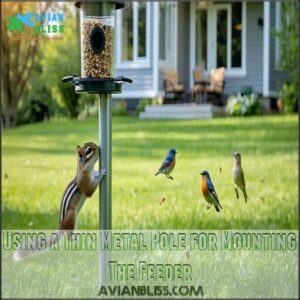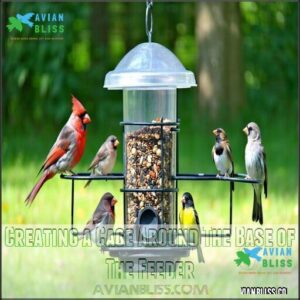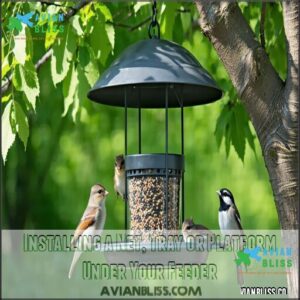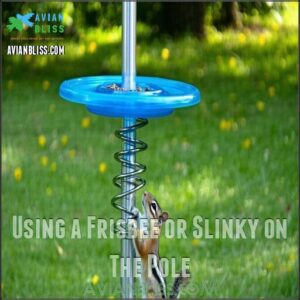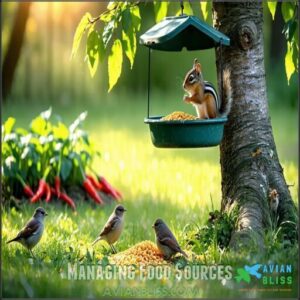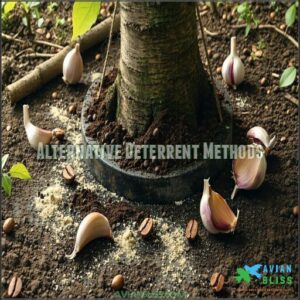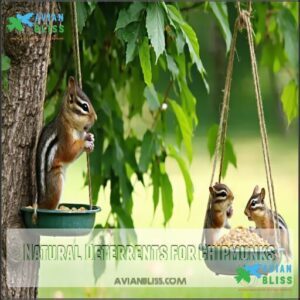This site is supported by our readers. We may earn a commission, at no cost to you, if you purchase through links.

To outsmart them, you’ll need some clever tricks. Here are 9 tips on how to keep chipmunks out of your bird feeder, including using chipmunk-resistant feeders and spicy seed mixes.
You’ll also learn how to create a chipmunk-proof landscape and use natural deterrents.
By following these tips, you’ll be able to enjoy watching your birds feast without those furry thieves crashing the party. Now, let’s get started and explore the best ways to keep those chipmunks at bay.
Table Of Contents
- Key Takeaways
- Choosing The Right Bird Feeder
- Mounting Your Bird Feeder
- Physical Barriers to Deter Chipmunks
- Managing Food Sources
- Using Spicy Food as a Deterrent
- Creating a Chipmunk-Proof Landscape
- Alternative Deterrent Methods
- Natural Deterrents for Chipmunks
- Maintaining Your Bird Feeder
- Frequently Asked Questions (FAQs)
- How to stop chipmunks from getting into bird feeders?
- What is the 5 7 9 rule for squirrels?
- What will keep chipmunks away?
- How to keep Chipmunks away from bird feeders?
- How do you keep Chipmunks on the ground?
- Do Chipmunks like bird netting?
- Do chipmunks eat bird food?
- How do you feed a chipmunk in a bird feeder?
- Can chipmunks eat a feeder?
- What repels chipmunks but not birds?
- Conclusion
Key Takeaways
- You’ll outsmart chipmunks by choosing the right bird feeder, like one with small feeding holes and a cage-like structure, to keep them from accessing the seed.
- You can deter chipmunks by using physical barriers, such as mounting your feeder on a smooth metal pole at least 7 feet from trees or structures, and adding baffles above and below the feeder.
- You’ll keep chipmunks away by managing food sources, like using safflower seeds or hot pepper added seed mixes, which they don’t like, and storing seed in tamper-proof containers.
- You can create a chipmunk-proof landscape by trimming shrubbery, planting wildlife-resistant bulbs, and maintaining a tidy yard, which will make your yard less appealing to these pesky critters.
Choosing The Right Bird Feeder
You’ll save yourself a lot of headaches by picking a bird feeder with small feeding holes and cage-like structures that chipmunks can’t access.
Choose feeders with small holes and cage-like structures to keep chipmunks out.
A well-designed feeder with metal components will keep those fuzzy thieves at bay while still welcoming your feathered friends to dine.
Selecting Chipmunk-Resistant Bird Feeder Designs
The battle against birdseed bandits begins with selecting the right feeder design. When shopping for a chipmunk-resistant feeder, prioritize durability and clever deterrent features.
Look for cage feeder designs that create a protective barrier—birds can slip through the openings while chipmunks remain locked out. Weight-activated feeders are particularly effective since they close automatically when triggered by a chipmunk’s weight.
Tube feeder durability matters too. Choose models made from metal or tough plastic that can withstand tiny teeth. Smart material selection prevents damage and extends your feeder’s lifespan.
Consider feeders with integrated baffles that make climbing impossible. Many squirrel proof feeders work equally well against chipmunks thanks to similar deterrent mechanisms.
The best chipmunk-resistant feeders combine multiple defense features: sturdy construction, protective cages, and slippery surfaces. Consider browsing options for chipmunk proof feeders for purchase. With the right feeder design in place, you’ll create a welcoming spot for birds while keeping determined chipmunks frustrated but unharmed.
Opting for Feeders With Small Feeding Holes
After selecting a sturdy feeder design, let’s talk about hole size matters – one of the simplest yet effective chipmunk deterrents.
Feeders with small feeding holes offer excellent bird accessibility while keeping chipmunks frustrated.
The right feeder material combined with tiny ports creates a perfect bird feeder solution for chipmunks.
Why small holes work so well:
- Finch-friendly openings – Tiny ports allow thin-beaked birds like goldfinches to feed while blocking chipmunk access
- Controlled seed dispensing – Less spillage means fewer ground-feeding opportunities
- Design limitations – Metal-reinforced ports prevent chipmunks from chewing to enlarge openings
Your feathered friends can feast while chipmunks stay stumped!
Avoiding Hopper Feeders and Open Trays
While small feeding holes limit chipmunk access, the feeder style itself is just as important.
Hopper feeders and open trays are like rolling out a red carpet for hungry chipmunks! These designs create excessive feeder spillage, turning your yard into a ground feeding hotspot.
Switch to tube feeders or models with weight-activated perches as an effective chipmunk deterrent.
For complete bird feeder protection, add a seed tray underneath to catch scattered seeds.
Suet alternatives mounted high on smooth poles offer another solution chipmunks can’t reach, providing a complete bird feeder protection with minimal seed waste.
Mounting Your Bird Feeder
You’ll win the battle against chipmunks with smart mounting strategies that keep your feathered friends happy and hungry critters frustrated.
Mount your bird feeder on a smooth metal pole at least 7 feet from trees or structures, and add baffles above and below to create an obstacle course that even the most determined chipmunk can’t overcome.
Using a Thin Metal Pole for Mounting The Feeder
One clever way to keep chipmunks away from your bird feeder is mounting it on a thin metal pole. These smooth surfaces prevent chipmunks from climbing up to raid your feeder, unlike wooden poles that offer easy grip.
For best results:
- Choose slender, galvanized steel poles for maximum smoothness and weather resistance
- Install your pole at least 7-10 feet high with proper ground clearance
- Position the pole at least 7 feet from trees, fences or structures to prevent jumping
- Confirm pole stability by embedding it deeply or using concrete for anchoring
The right pole material makes all the difference. Watching a chipmunk try to shimmy up your slippery metal pole and slide right back down is both effective and entertaining! Your feathered friends can feast in peace while you enjoy uninterrupted bird watching from your window. Remember, proper feeder placement is half the battle in chipmunk-proofing your yard.
Installing a Baffle Above and Below The Feeder
Installing baffles transforms your feeding station into a chipmunk-free zone.
Mount smooth plastic or metal baffles both above and below your bird feeder for complete protection.
The bottom baffle prevents climbing chipmunks, while the top one blocks jumpers from accessing your feeder.
For proper baffle placement, position them at least 4-5 feet off the ground, using materials that chipmunks can’t grip.
A 12-inch diameter baffle creates an effective barrier—whether you choose dome-shaped plastic or slippery cone designs.
Many hardware stores sell ready-made feeder baffles, or you can craft your own from mixing bowls or sheet metal.
A bird feeder baffle can greatly improve your setup.
Remember, proper installation height guarantees these simple barriers keep seeds for birds only, making your feeder a bird-friendly spot with a complete protection system, and it is essential for a chipmunk-free environment.
Creating a Cage Around The Base of The Feeder
Beyond installing baffles, a sturdy cage around your feeder’s base creates an effective chipmunk barrier while still allowing birds to feed.
Follow these steps for a successful installation:
- Select galvanized wire mesh with openings of 1/4-inch or smaller – chipmunks can squeeze through surprisingly tiny spaces!
- Build the cage at least 8 inches taller than your feeder’s lowest point to prevent climbing access.
- Anchor the cage securely into the ground with metal stakes to stop determined diggers.
This squirrelproof solution provides excellent bird access while keeping wildlife like chipmunks from raiding your bird feeders.
Physical Barriers to Deter Chipmunks
You can stop those sneaky chipmunks from raiding your bird feeder by setting up simple physical barriers that block their path.
Block chipmunks with simple barriers for a peaceful bird feeder experience
Adding a well-placed tray under your feeder or wrapping a slinky around the pole creates obstacles that chipmunks can’t overcome, letting your feathered friends dine in peace.
Installing a Net, Tray or Platform Under Your Feeder
Birds aren’t exactly neat eaters, which is why catching spilled seed is essential for chipmunk control. Installing a net, tray, or platform under your feeder creates an effective barrier while reducing seed waste.
These accessories serve two important purposes: they prevent ground feeding by hungry chipmunks and help maintain bird health by keeping food off damp ground where it can mold. For a more effective approach, consider using squirrel baffles on your bird feeder.
| Barrier Type | Benefits | Materials | Maintenance |
|---|---|---|---|
| Seed Catchers | Prevents ground feeding | Mesh, plastic | Weekly cleaning |
| Platform Designs | Collects scattered seeds | Wood, metal | Monthly scrubbing |
| Feeder Trays | Easy cleaning | Plastic, wire | Regular emptying |
| Bird Feeder Guards | Complete protection | Metal mesh | Occasional repairs |
Many bird enthusiasts find that spillage reduction devices quickly pay for themselves in saved birdseed alone, which is a significant advantage for those looking to optimize their bird feeding experience.
Using a Frisbee or Slinky on The Pole
You can stop chipmunks with a Slinky or Frisbee on the pole.
Wrap a Slinky around it for a wobbly barrier. Attach a Frisbee midway as a baffle.
This turns your feeder pole into a chipmunk-proof setup, keeping snacks safe from sneaky critters.
Use durable pole materials and consider installation height for maximum effectiveness.
Managing Food Sources
You can manage food sources to keep chipmunks away from your bird feeder by using certain types of seed.
By choosing the right seed, like safflower seeds or hot pepper added seed mixes, you can make your feeder less appealing to chipmunks.
Installing a Seed Tray or Platform Under The Feeder
You can reduce spillage with seed trays or platforms.
Here are tips:
- Pick sturdy materials
- Secure it well
- Clean regularly for easy cleaning and feeder protection, reducing ground mess and seed waste, which aids bird health.
Using Safflower Seeds or Hot Pepper Added Seed Mixes
You’re looking for ways to outsmart chipmunks at your bird feeder. Try safflower seeds, a bitter snack for them. Hot pepper seeds are another option, thanks to capsaicin.
| Seed Type | Benefits |
|---|---|
| Safflower | Deters chipmunks |
| Hot Pepper | Capsaicin tolerance |
| Regular | Attracts birds |
| Spicy Mixes | Dual deterrent |
Experiment with spice levels to find what works best. Safflower seeds and hot pepper seed mixes can be effective deterrents.
Storing Seed in Tamper-Proof Containers
Store seed in tamper-proof containers made of metal or heavy-duty plastic with airtight lids. Consider airtight container benefits for ideal seed preservation.
- Choose rodent-proof material
- Select a cool storage location
- Check lids regularly for pest prevention and seed freshness to ensure optimal storage conditions.
Using Spicy Food as a Deterrent
You can use spicy food as a deterrent to keep chipmunks out of your bird feeder.
By adding cayenne pepper or hot sauce to your birdseed, you’re creating a flavor that’s unappealing to chipmunks, but still safe for birds to eat.
Adding Cayenne Pepper or Hot Sauce to Birdseed
You can spice up your birdseed with cayenne pepper to keep chipmunks away.
This spicy deterrent is eco-friendly and won’t harm birds. Adjust the spice level for maximum impact.
Cayenne pepper’s capsaicin causes taste aversion in mammals, making it effective. Introduce it gradually to guarantee birds aren’t affected.
Mix hot sauce into seed for a similar effect. This simple trick keeps chipmunks out, letting you enjoy birdwatching without fuss.
Using Coles Hot Pepper Sunflower Seeds
You’re outsmarting chipmunks with Coles Hot Pepper Sunflower Seeds!
- They contain capsaicin
- Repel chipmunks
- Attract birds
- Easy to use
- Cost-effective, these spicy seeds are a clever deterrent, leveraging capsaicin effectiveness and bird tolerance to safely guard your bird feeders from chipmunks.
You can buy Coles products online, which is a cost-effective way to protect your bird feeders.
Understanding Capsaicin’s Effect on Mammals
You’re trying to keep chipmunks away from your bird feeder.
Capsaicin, found in cayenne pepper and hot pepper seeds, is a natural deterrent.
It activates pain receptors in mammals, making them feel the burn.
But don’t worry, birds are immune.
They can eat spicy seeds without a problem.
This is because birds lack the receptors that make mammals sensitive to capsaicin.
By using spicy deterrents, you can keep chipmunks away without harming them.
Mix cayenne pepper into your seed or use pre-spiced options.
Find the right spice balance to deter chipmunks without affecting birds.
This method is safe and eco-friendly, making it a great bird feeder tip for keeping chipmunks at bay.
Creating a Chipmunk-Proof Landscape
You’re taking steps to keep chipmunks out of your bird feeder, and now it’s time to focus on creating a chipmunk-proof landscape.
By trimming shrubbery, planting wildlife-resistant bulbs, and maintaining a tidy landscape, you can make your yard less appealing to these pesky critters.
Trimming Shrubbery Around Your Feeder
You can deter chipmunks by trimming shrubbery around your bird feeder.
- Exposing burrows encourages relocation
- Eliminating hiding spots helps
- Spotting visitors is easier with tidy yards
- Pruning frequency matters for pest control.
Keep your yard tidy to outsmart chipmunks and protect your bird feeders from these wildlife deterrents.
Planting Wildlife-Resistant Bulbs
You can outsmart chipmunks by planting wildlife-resistant bulbs like daffodils and hyacinths.
These bulbs are toxic to chipmunks, making them a great chipmunk prevention technique. Plant them deep in well-draining soil to prevent chipmunk access, a simple yet effective bird feeder solution for chipmunks.
This wildlifefriendly gardening method helps deter chipmunks.
Creating a four-season garden will further support local bird populations.
Maintaining a Tidy Landscape
Think of your yard as a fortress against chipmunks.
Here’s your battle plan:
- Trim bushes.
- Mow often.
- Remove weeds.
Regular Lawn Maintenance and Pruning Techniques create Open Spaces. Debris Removal stops chipmunks from nesting.
Garden cleanliness is key. Combine this with spilled seed management around bird feeders. Store seed well. You’ll win against chipmunks.
Alternative Deterrent Methods
You’re looking for ways to keep chipmunks out of your bird feeder, and you’ve tried some methods already.
Now, you can try alternative deterrent methods, such as using coffee grounds or garlic as repellents, to keep those pesky chipmunks away from your bird feeder.
Using Coffee Grounds or Garlic as Repellents
You can keep chipmunks away from your bird feeder using coffee grounds and garlic.
These natural repellents have strong smells that chipmunks hate. Sprinkle them around your feeder area for a simple solution.
Coffee grounds enrich soil while garlic protects plants. Reapply after rain to maintain effectiveness.
Combine both for a multi-sensory deterrent. This eco-friendly method is budget-friendly too, keeping your bird feeder chipmunk-proof with coffee grounds benefits and garlic scent effectiveness.
Installing a Motion-Activated Sprinkler
You’re looking for a fun way to scare off chipmunks.
Try a motion-activated sprinkler!
- It startles them with water
- Has adjustable sensor sensitivity
- Comes in eco-friendly models
- Requires proper maintenance
This is a great chipmunk prevention technique for your bird feeder.
Contacting a Wildlife Removal Expert
You’ve tried everything, but chipmunks persist.
Now, call a wildlife expert for humane removal. They’ll assess damage, provide prevention advice, and relocate the critters.
Expert costs vary, but it’s worth it for legal and safe removal.
A wildlife expert will help you reclaim your yard, offering humane animal removal and wildlife management solutions, ensuring a chipmunk-free bird feeder.
Natural Deterrents for Chipmunks
You’re looking for ways to keep chipmunks out of your bird feeder, and natural deterrents can be a great option.
By using methods like squirrel-proof feeders, setting up a separate feeding station, and offering shelled sunflower seeds, you can effectively keep chipmunks away from your bird feeder.
Using Squirrel-Proof Feeders
You can outsmart chipmunks with squirrelproof feeders.
- Use weight-activated designs
- Choose cage-style feeders
- Install baffles for extra defense
- Mount on metal poles
These feeder mechanisms offer chipmunkresistant solutions.
Weight activation and cage design block chipmunks, while baffle effectiveness and material durability guarantee long-lasting protection, making them ideal bird feeder solutions for chipmunks, providing wildlifeproof and animalproof features.
Setting Up a Separate Feeding Station
Set up a separate feeding station with these 4 tips:
- Choose a location 10 feet away
- Use low platforms
- Offer preferred foods
- Store food securely, using Distraction Feeding as a Location Strategy for chipmunk control with chipmunk-resistant feeders.
Offering Shelled Sunflower Seeds
You can use shelled sunflower seeds to keep chipmunks away.
| Seed Type | Bird Preference | Chipmunk Prevention |
|---|---|---|
| Shelled | High | Yes |
| Unshelled | Medium | No |
| Safflower | Low | Yes |
This reduces waste and saves you money, making it a win-win for bird feeding and chipmunk control.
Maintaining Your Bird Feeder
You’re taking steps to keep chipmunks out of your bird feeder, and maintaining it’s key.
By regularly cleaning up fallen seed and storing birdseed in airtight containers, you’ll be well on your way to a chipmunk-free feeder.
Regularly Cleaning Up Fallen Birdseed
Regularly sweep up fallen seed to prevent chipmunk attraction.
Add seed trays under feeders for spill prevention, keeping your yard tidy and making cleaning easier, which helps with mold prevention and reducing attraction, following key bird feeding tips for effective chipmunk prevention techniques and better garden cleanliness.
Consider offering diverse seed mixes to attract a variety of birds, utilizing effective chipmunk prevention techniques.
Inspecting for Signs of Chipmunk Intrusion
As you tend to your bird feeders, keep an eye out for feeder damage, seed spillage, and burrow locations.
Identify chipmunk tracks and nesting materials to stay ahead of these pests.
By monitoring your yard, you’ll prevent chipmunks from taking over, protecting your bird feeders and implementing effective chipmunk prevention strategies, which is crucial for maintaining a safe environment and this will help in preventing them from causing further damage.
Storing Birdseed in Airtight Containers
You often find yourself battling chipmunks for birdseed.
Store seed in airtight containers made of metal or heavy-duty plastic to keep it fresh and dry.
- Choose metal or thick plastic
- Keep lids sealed
- Avoid outdoors
- Inspect for chew marks
This keeps your seed safe from rodents and guarantees seed freshness, preventing chipmunk prevention issues for bird feeders.
Frequently Asked Questions (FAQs)
How to stop chipmunks from getting into bird feeders?
You’re the captain of your yard, and chipmunks are pirates trying to raid your bird feeder; outsmart them with chipmunk-proof feeders and spicy seed mixes.
What is the 5 7 9 rule for squirrels?
You’ll want to remember the 5-7-9 rule: place feeders 5 feet off the ground, 7 feet from structures, and 9 feet from jumping points to outsmart those sneaky squirrels.
What will keep chipmunks away?
Don’t worry, you can outsmart them. Using spicy seeds, metal poles, and baffles will keep chipmunks away from your bird feeder, letting you enjoy the birds without the pesky critters.
How to keep Chipmunks away from bird feeders?
You can keep chipmunks away by using physical barriers, seed management, and habitat modification, such as mounting feeders on smooth poles and offering spicy seed mixes they dislike.
How do you keep Chipmunks on the ground?
For example, placing feed on the ground away from your bird feeder can distract chipmunks, you can try putting some seeds there to lure them away from your feeder.
Do Chipmunks like bird netting?
You’ll find chipmunks don’t like bird netting, as it’s difficult for them to climb and doesn’t provide a comfortable surface to grip, making it a good deterrent.
Do chipmunks eat bird food?
You’ll notice chipmunks do eat bird food, especially seeds, as they’re attracted to easy meals, so this is key to using chipmunk-resistant feeders or seed types they dislike.
How do you feed a chipmunk in a bird feeder?
You’re unwittingly hosting a chipmunk buffet, so try placing their favorite foods in a separate feeder, away from your bird feeder, to distract them.
Can chipmunks eat a feeder?
You can’t let chipmunks eat from your feeder, they’ll chew and damage it, so use chipmunk-proof feeders or try deterrents like hot pepper seeds to keep them away safely.
What repels chipmunks but not birds?
You can repel chipmunks with hot pepper seeds or suet, as they contain capsaicin, which deters them but doesn’t harm birds, making it a safe and effective solution.
Conclusion
Now you’re the guardian of your bird feeder.
You’ve learned 9 tips on how to keep chipmunks out of your bird feeder.
By using these tips you’ll outsmart those pesky critters and enjoy watching birds feast.
Remember to stay one step ahead of chipmunks with these 9 tips on how to keep chipmunks out of your bird feeder and keep your yard chipmunk-free.
- http://www.wildlifeanimalcontrol.com/chipmunksbirdfeeder.html
- https://www.scatteredthoughtsofacraftymom.com/make-a-bird-seed-catcher-for-your-bird-feeder/
- https://jcswildlife.com/absolute-ii-squirrel-proof-bird-feeders-green-heritage-farms-7536-pole-and-hanger-included/?ref=hVhUWmk6vKk1IL
- https://sprigandspoon.com/how-to-repel-chipmunks/
- https://www.angi.com/articles/how-to-get-rid-of-chipmunks.htm


